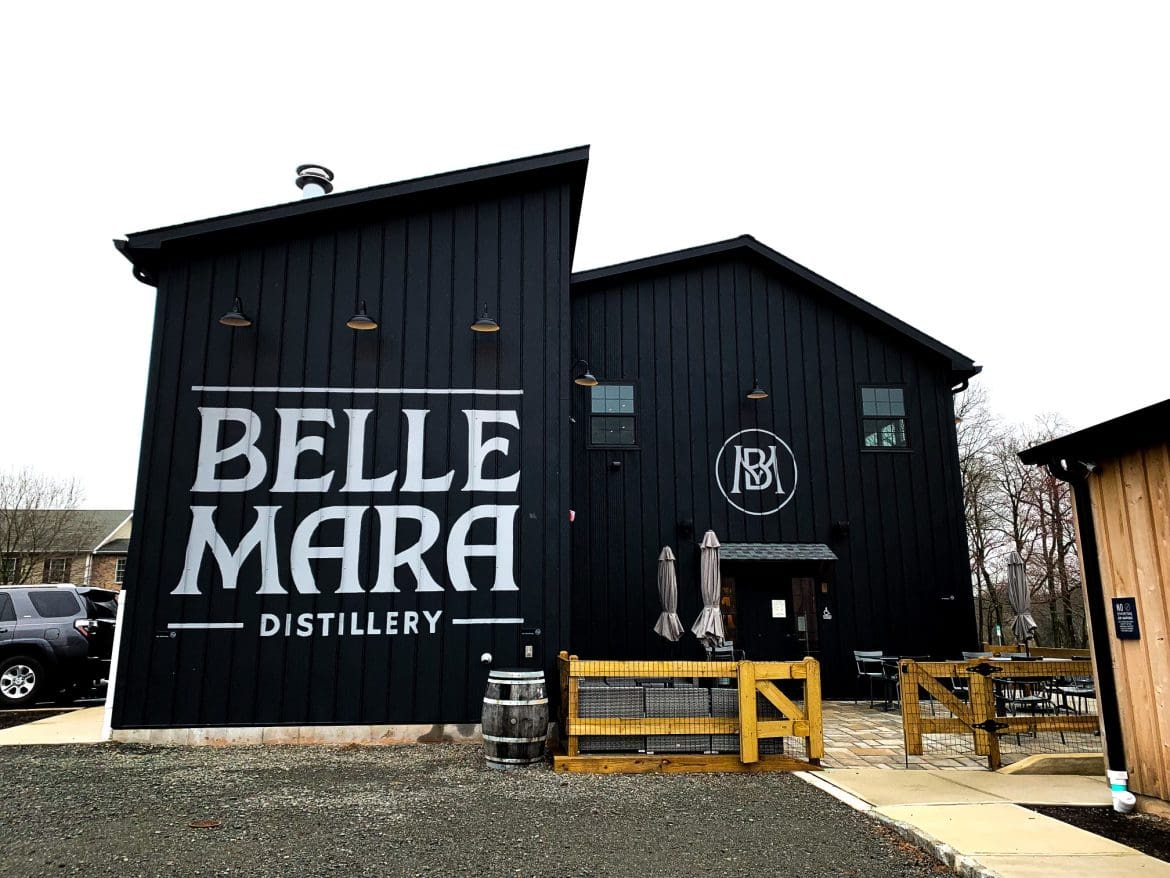Over 35 million liters of alcohol are enjoyed globally each year, but few people truly understand the hard work and dedication that is required for that spirit to end up in your glass. It starts at a farm where a grain is grown, the grain is then processed by maltsters and millers before finally making its way to a distiller. From the distiller, it goes to distribution, then to bars and restaurants, and finally into your glass. Many gloss over just how much land the bottle you may enjoy on a weekend must cover before making its way to you.
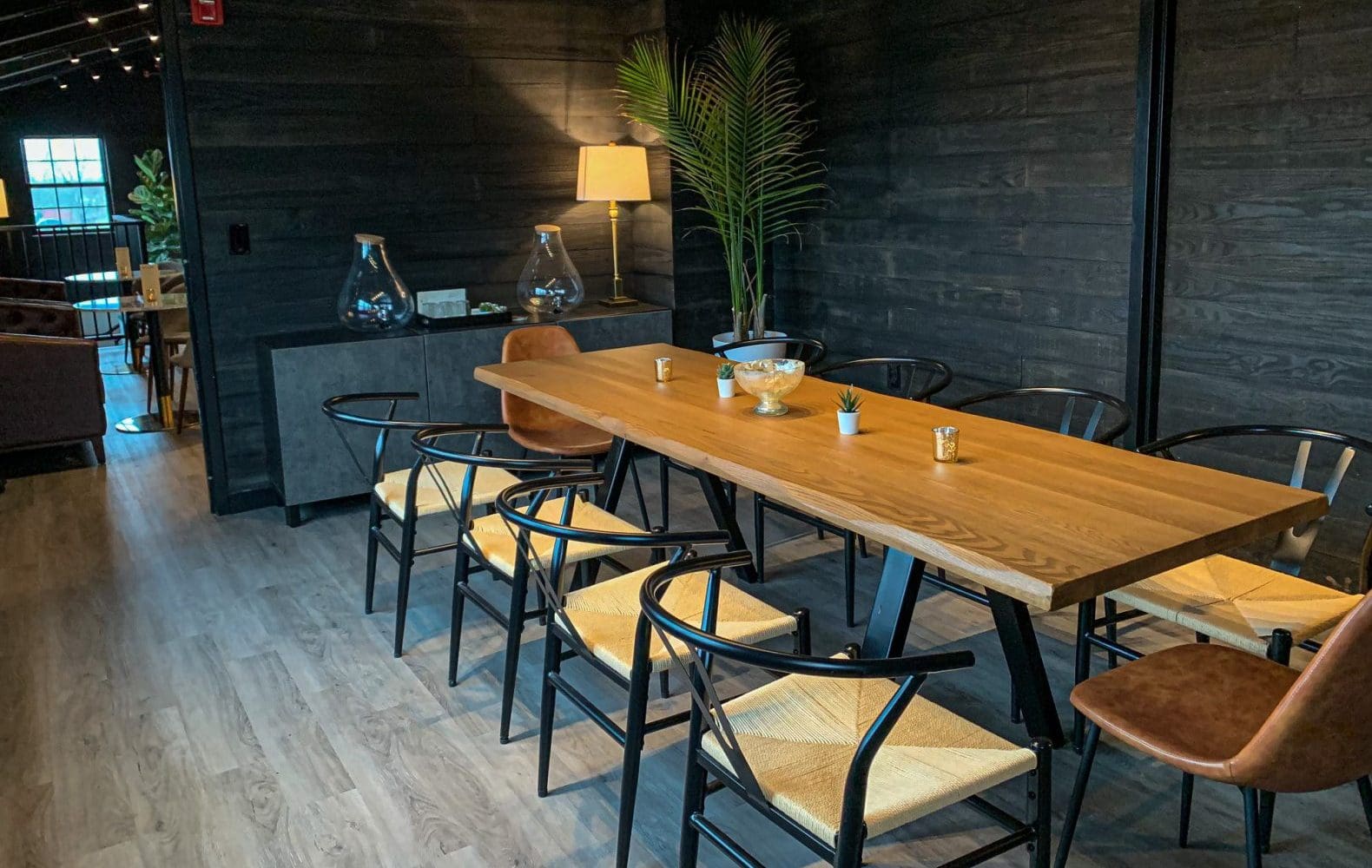
Upstairs lounge at Bellemara Distillery
Many producers try to shorten this journey by buying pre-distilled spirits and ingredients and then repackaging them as “craft,” “handmade,” or “local,” when the actual alcohol in the bottle is anything but. However, at one distillery in Central New Jersey, all of the distilling work is done right there on premises. The next time you revel in an expertly crafted drink in the second-floor lounge at Bellemara Distillery in Hillsborough Township, NJ, you can drink with a new outlook, knowing that the very spirit you are enjoying was crafted 15 feet away from you in a process known as grain to glass distilling. Head distiller and co-owner, Camden Winkelstein, exemplifies craftsmanship in its rawest form by turning malted barley into some of the finest single malt spirits that one could ask for.
Neighbors with Flounder Brewing Co., the two businesses have adjacent outdoor patio spaces that are both sleek, and comfortable. This presents a variety that many distilleries do not have, and an opportunity to try multiple different products from two renowned institutions. Maybe you want to drink a cocktail at Bellemara, and take a six-pack home from Flounder Brewing, or you might want to enjoy a beer on the brewery patio, and then take something from Bellemara home. Tours, tastings and classes are even available for guests who want to go beyond just enjoying a drink. The options are vast, and the proximity provides a unique quality that many distilleries and breweries lack.
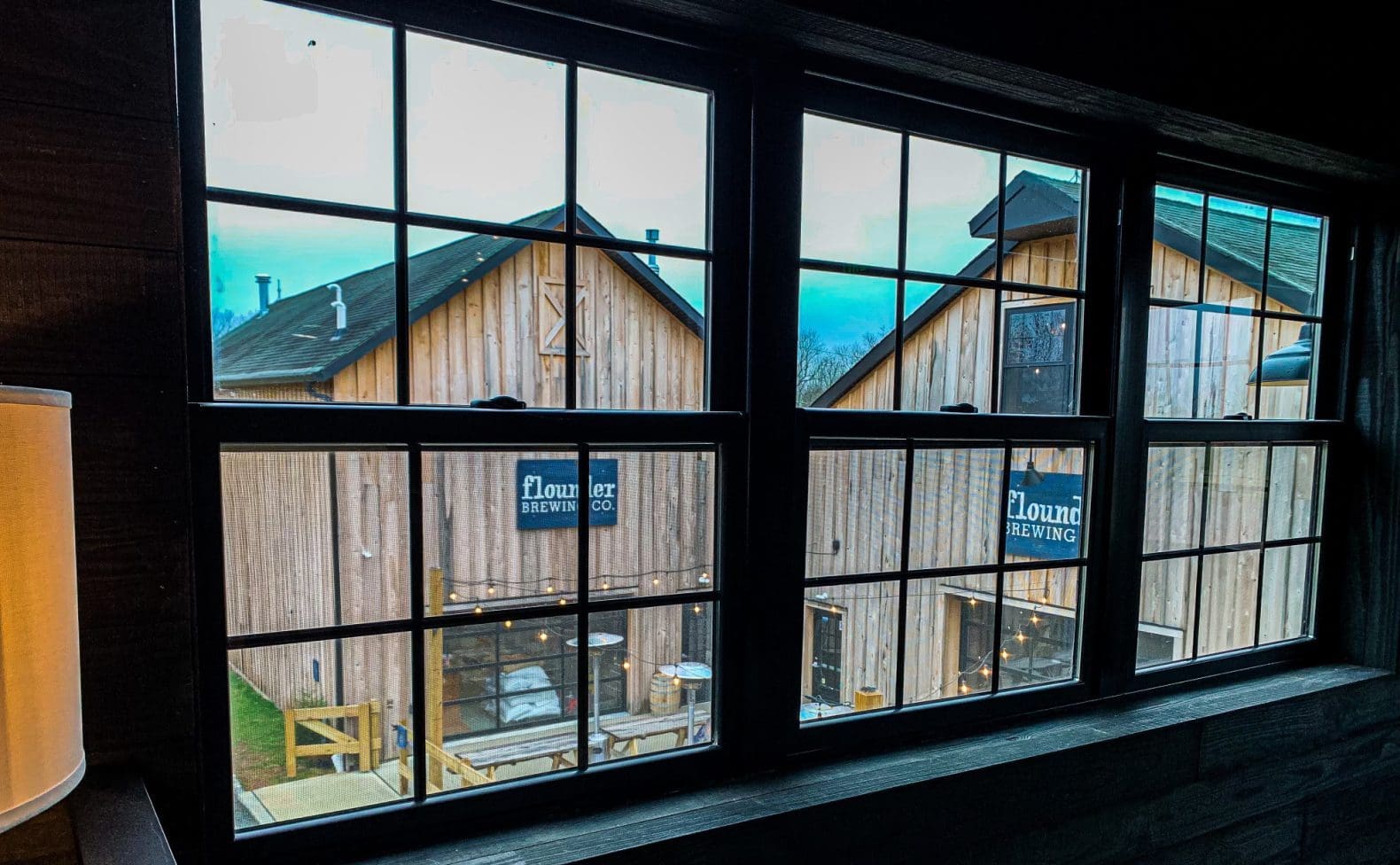
Flounder Brewing as seen from the upstairs lounge
Like any success story, there was a long journey before landing there.
While it may seem like second nature, Winkelstein didn’t always make liquor. He spent seven years as a U.S. Navy Submarine Officer before ultimately leaving to find his passion and turn it into a career. From there, he took the things he cared about most and combined them into one: engineering and craft spirits and brewing.
Originally, Winkelstein thought of going the brewery route. “I was trying to figure out what to do with my life. I knew I wanted to start a business—for a while, I was thinking about maybe opening a brewery, but when I looked for breweries to learn in, nowhere was hiring,” Winkelstein told me, “I thought to myself; what’s the next best thing? I can go and get educated,” he continued.
A love for Scotch whisky led him to Scotland where he obtained a Master of Science in Brewing and Distilling from Heriot-Watt University in Edinburgh, which was the only English-speaking Masters degree available in brewing and distilling science at the time. Returning home to the U.S., Winkelstein felt ready to dive headfirst into his own business. The focus? None other than single malt spirits.
He first got his feet wet working with other distilleries throughout the state, all while honing his business model into what you’ll find today when walking into Bellemara. Winkelstein and his wife, Christina Lee, traveled around the world tasting hundreds of whiskies before settling on a style that they agreed suited their vision best. At the tail end of 2021, Winkelstein and Lee opened their doors after years of preparation. And when walking through those doors, that business model, and Winkelstein’s and Lee’s image, is put on full display right before your eyes.
The beginning of that image starts at a farm, with a grain. Winkelstein went on to explain to me how the process of making a single malt spirit begins. “We’re a single malt distillery, so we’re making everything from malted barley. Barley is a grain, and just like any other grain, it is grown in a field by a farmer. It’s then put through a malting process where it gets soaked in water, germinates, and then releases an enzyme. From there, it is dried out—allowing for maximum shelf-life. The product you are left with is known as malted barley.
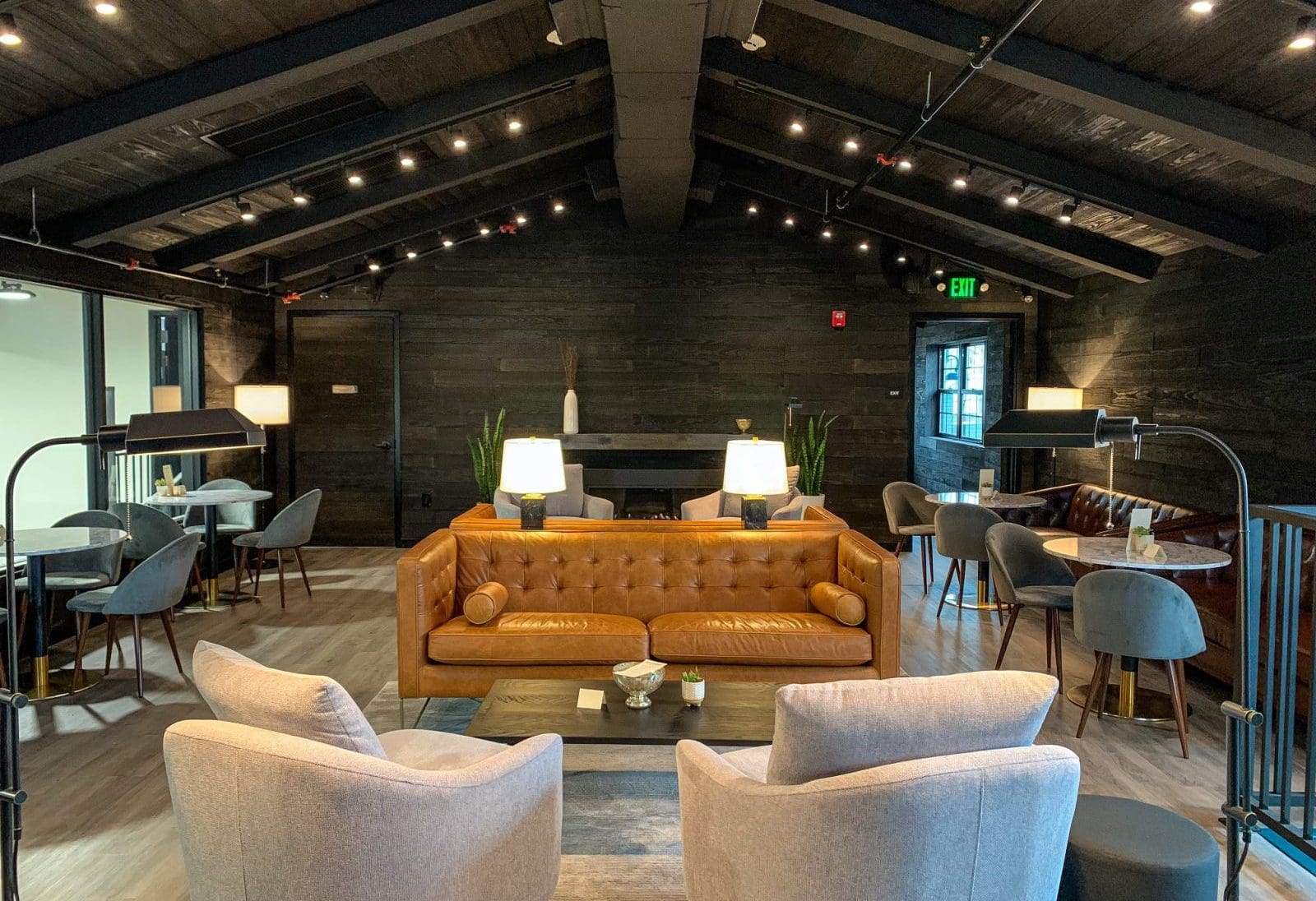
Upstairs lounge at Bellemara Distillery
The malted barley is what initially arrives at the distillery, and it’s the canvas in which Winkelstein and his team work upon. From there, 275-pound batches of the grain go into a stainless steel mash tank, where it’s mixed with hot water to reactivate the enzymes which were released during the malting process. This step is one of the most crucial to the final product. As the enzymes are released from the grain, they convert the starch into sugar, which is imperative to creating alcohol. “We start with oatmeal, and we turn it into sugary oatmeal,” Winkelstein joked.
From there, the liquid is separated from the “oatmeal” and cooled down. And while the grain husk that’s left behind has no role in the process any longer, it can still be repurposed as animal feed. So, Bellemara sends it out to local farms, where it is consumed by cattle and other livestock.
As the strained liquid is cooled, yeast is added, which then converts the sugar into alcohol. This liquid is fermented for four days, and is known as a wash. The wash you’re left with sits at around six-and-a-half percent alcohol by volume.
To this point, the actual distillation process has yet to even begin. But that all changes with this next step. The liquid is added to copper stills, heated up, and alcohol is boiled off to be collected. This does two things to the product: it reduces the volume of the liquid, and it concentrates the alcohol percentage, raising the level all the way up to around 32 percent. What you are left with after this first distillation is something known as low wines.
The aforementioned stills are one of the first things that catch your eye when walking into Bellemara. These are not easy to come by, and Winkelstein did not take the easy way out in obtaining them. The two stills were custom designed by Winkelstein himself and made in Italy specifically for Bellemara. They tower over you with their copper finish, letting you know what you’re about to drink is going to be special. How could it not be? It was made right there in front of you, all within the image of a true craftsman.
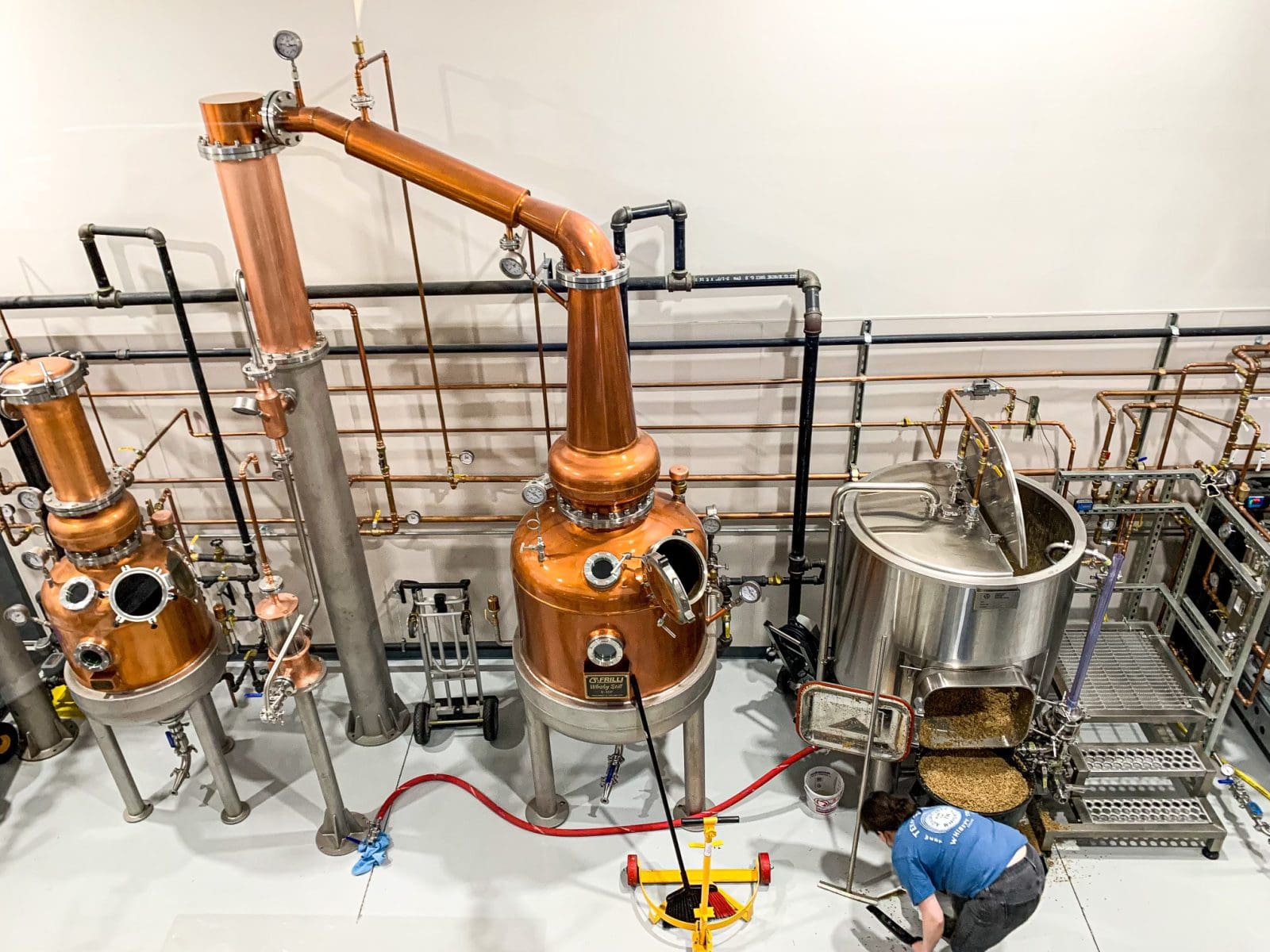
Custom designed copper stills at Bellemara Distillery
That’s where Winkelstein’s background in engineering gave him a leg up when entering the world of distillation. While many spirit makers would research and order a still that works best for their product, Winkelstein found that designing it himself would be even more beneficial. That way, he could control every aspect of one of the most important tools at the distillery. “When doing research, I looked at the stills used to make whiskies that I loved to drink, and took a some inspiration from each,” Winkelstein admitted. He put a pencil to paper, and designed every last inch of each of Bellemara’s copper stills, ensuring that the products they would be making were truly in their image—in every sense of the phrase.
The second distillation then takes place, a process known as a spirit run. The liquid is again heated, bumping the alcohol percentage all the way up to over 80 percent. “This spirit run is where we separate the heads, hearts, and tails. The heads of our run are stuff like methanol; really high in the wrong kind of alcohol…It will make you go blind. We throw that out,” Winkelstein told me. “The hearts of the run are what we want to collect. Ethanol… alcohol that tastes good.”
So, the hearts are collected over the course of around four hours, at which point, the distiller will choose when to cut off the collection as flavor changes and alcohol content decreases. At Bellemara, the back two-thirds of the run is what they would consider the tails—this can be recycled for future spirit runs.
For all of the products at Bellemara, these beginning steps remain the same. The process then changes depending on what is being made. For their Single Malt Spirit, they proof the liquid down to 60 percent alcohol, carbon filter it to take the raw edge off of the palate, and then the ABV is lowered once more to 40 percent before being bottled.
Bellemara’s Single Malt Spirit is clear and neutral in flavor, all while retaining a complexity around the edge that is often missed entirely within the category. While it is their answer to a vodka, Bellemara’s Single Malt Spirit to me is much more pleasant to drink than your standard vodka, and the terroir of the malted barley makes for a neutral spirit that is extraordinarily interesting.
The same spirit can be turned into an array of products. Winkelstein and his team distill the liquor a third time with added flavors such as juniper and orange peel, creating Bellemara’s signature gin. The lightly floral notes and robust citrus flavor makes for a gin that is both delightful when sipped neat, or a remarkable base on which a cocktail can be built.
Winkelstein is a whisky-maker at heart, though. And while his American Single Malt Whisky is still being aged in new charred American Oak barrels, he is confident in the quality that will come out of the barrel after two to four years of aging. Like the Single Malt Spirit, this is proofed down to around 60 percent alcohol, before being added to barrels to age.
Bellemara amplifies the versatility of a good base spirit by showcasing how seamlessly it can be turned into three uniquely distinct products. A mix of newcomers and regulars enjoy drinks at Bellemara each day, but the dedication to making something special is not lost on critics either. The San Francisco World Spirits Competition awarded a silver medal to the Bellemara Gin, and a gold medal to the Bellemara Single Malt Spirit this year. Regulars at the distillery already recognize the greatness that Bellemara produces every single day, but with prestigious awards under their belt now, Winkelstein and the entire team’s adroitness is being applauded nationwide.
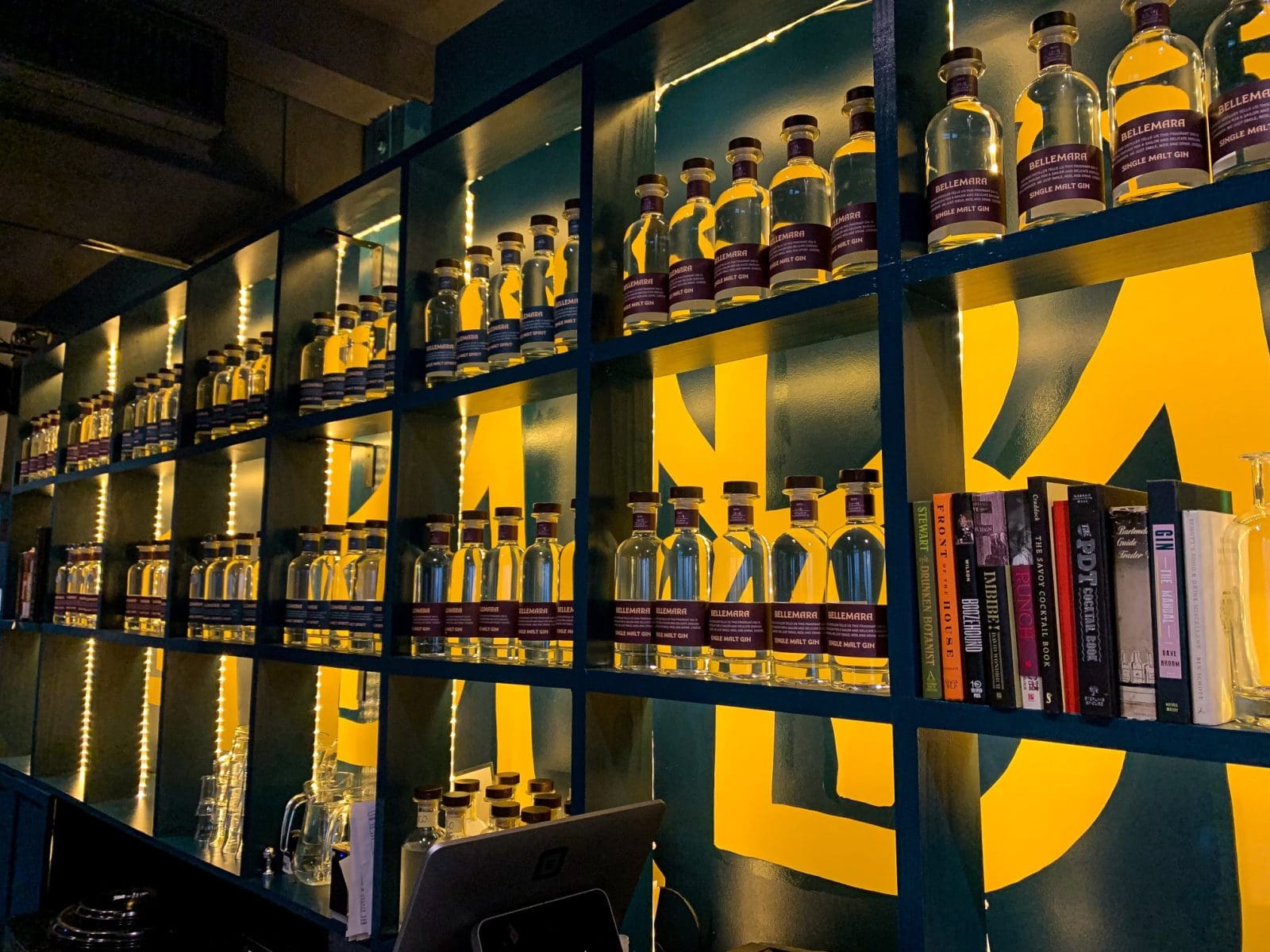
Award winning spirits at Bellemara Distillery
What is so impressive at Bellemara Distillery is how seamlessly this hard work transfers over to their bar program. Because of laws and regulations in the state of New Jersey, distilleries are not allowed to carry any alcoholic product that is not their own. This makes creating drinks that call for additional, specific products rather difficult.
That is where tasting room manager and cocktail curator, Russell Aagenes, comes into the picture. Using their single malt spirit, Aagenes and Winkelstein have developed two aperitifs—a dry type of alcohol usually served before a meal. Their bitter hibiscus aperitif works perfectly as a replacement for your typical bitter red spirit that you might find in a spritz or a Negroni. The dry aperitif is used in their house martini, replacing dry vermouth entirely.
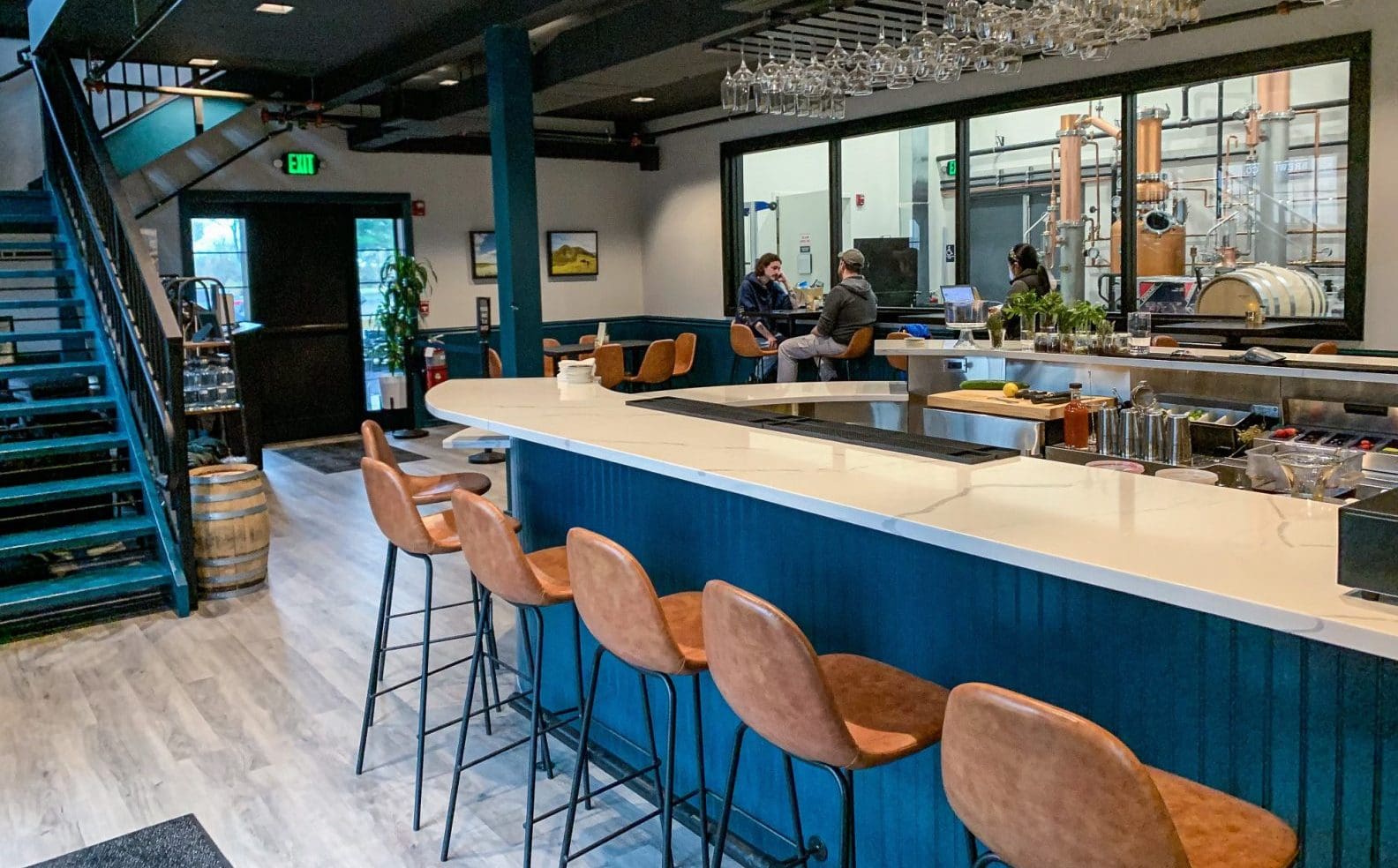
The bar at Bellemara Distillery
This is without a doubt an obstacle, but it is one that Bellemara not only conquers, but uses to their advantage. There is truly a cocktail for everybody on their list, and if you can’t find one that is exactly to your liking, a build your own gin and tonic is available allowing the guest to customize every aspect of their beverage, from herbs and fruit to syrups and spices. This is just another touch that sets Bellemara Distillery apart from the rest.
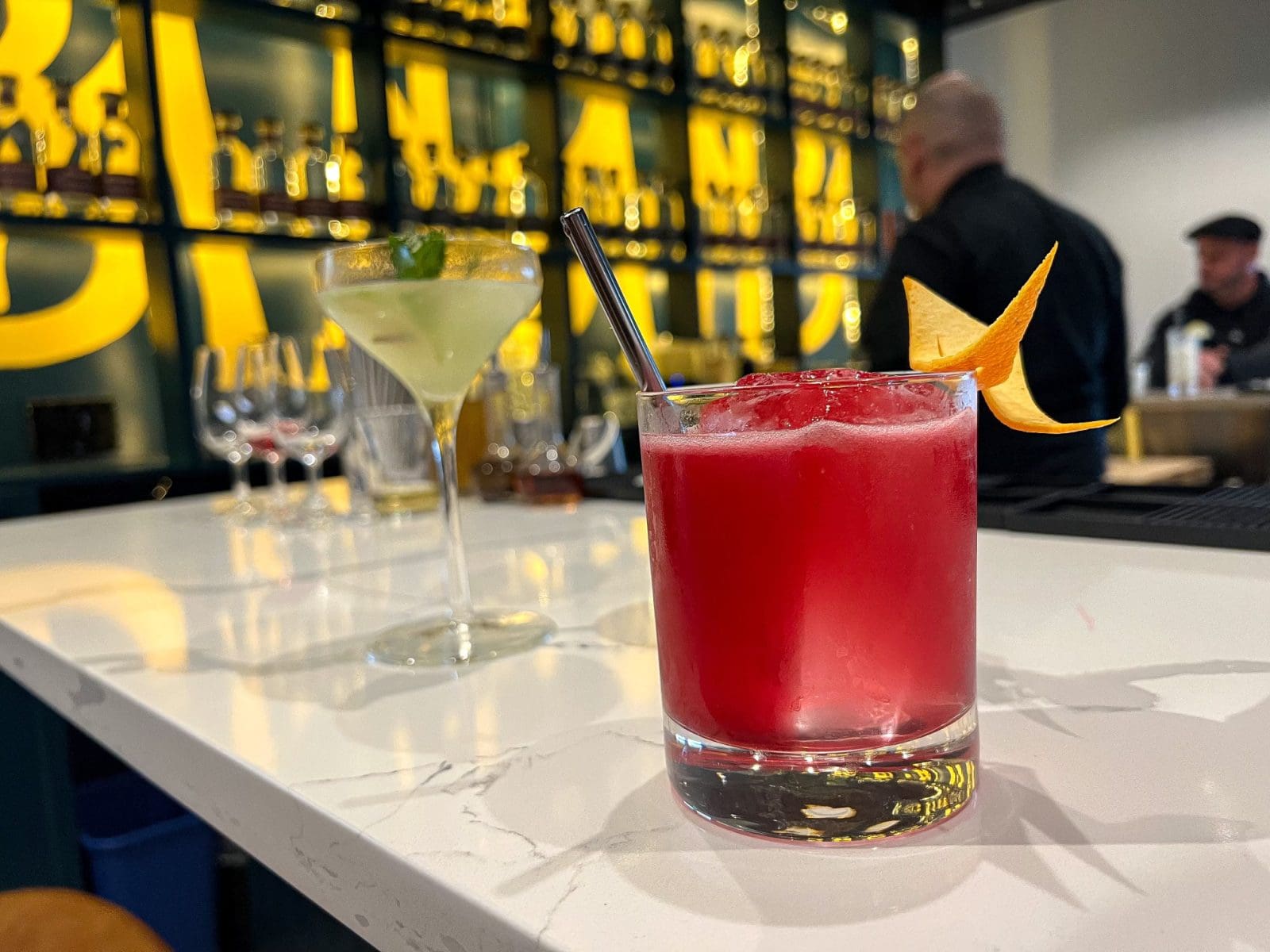
Craft cocktails at Bellemara Distillery
When asked about the philosophy behind his business, Winkelstein told me that making everything on premises was of the utmost importance to him when opening Bellemara. “What’s the point of having a craft distillery if you’re just buying an industrial bourbon and rebottling it with your name on it?” (A practice that Winkelstein went on to explain is unfortunately common in the world of distilleries.) “I won’t be able to sell whisky for a few years because it needs to age, but that’s fine by me if it means I am making it all myself,” he continued.
Bellemara is many things. It’s a distillery, it’s a bar, and it’s a place to hang out; but, above all, it is a culmination of talent and skill that is put on display for our enjoyment. Every team member works toward the same goal, and that goal is to make something that people are going to love. The name Bellemara, roughly translating to “beauty of the sea,” is the perfect description of their craftsmanship. Whisky and spirits are complex and change over time, like the ocean with its tides. That ebb and flow, as Winkelstein put it, has become an inspiration to push out something remarkable each and every day. Whether you want to savor an expertly crafted drink at the bar, or are just looking for a cozy place to hang out like in their upstairs lounge, the fact remains that Bellemara Distillery offers a new perspective on craft spirits.
About the Author/s
Peter Candia is the Food + Drink Editor at New Jersey Digest. A graduate of The Culinary Institute of America, Peter found a passion for writing midway through school and never looked back. He is a former line cook, server and bartender at top-rated restaurants in the tri-state area. In addition to food, Peter enjoys politics, music, sports and anything New Jersey.
